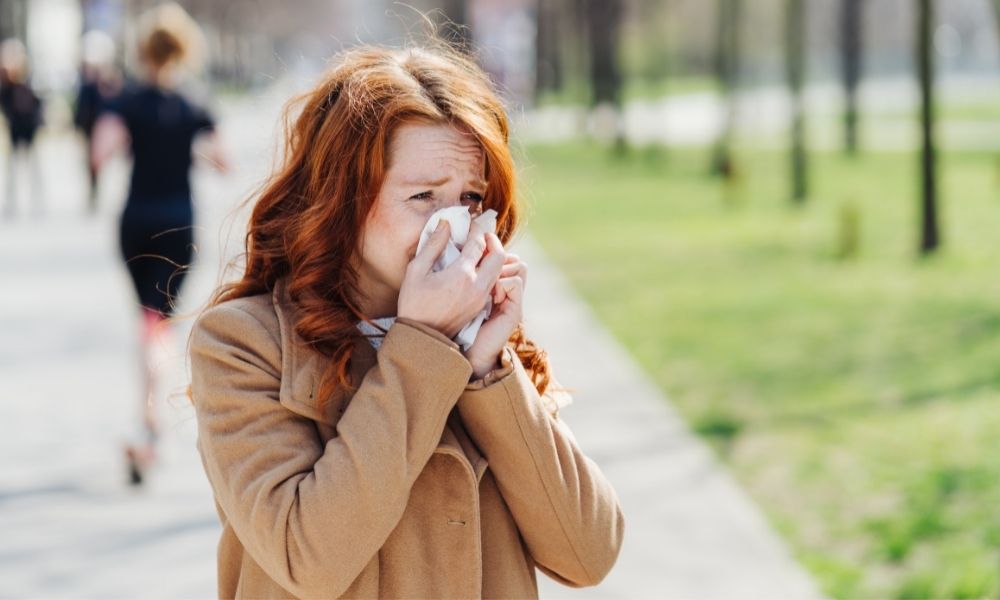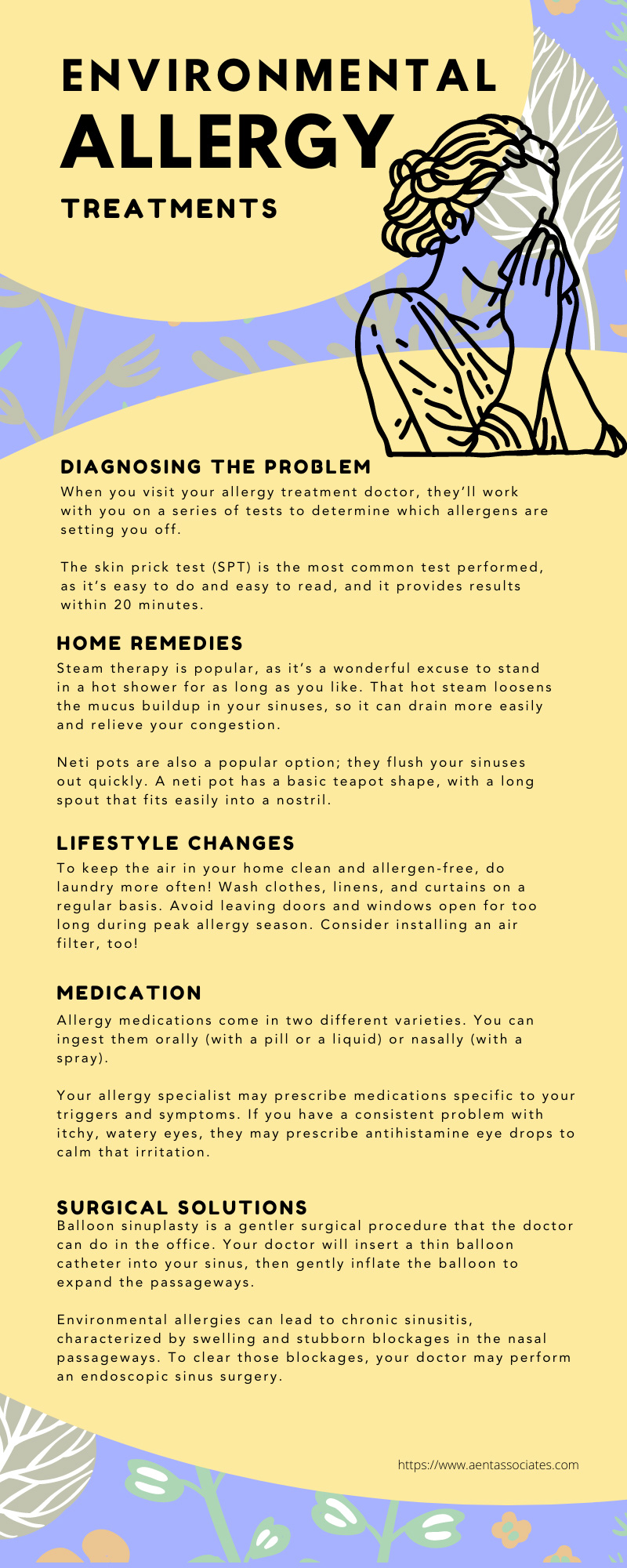
Environmental allergies are the bane of many people’s existence—you’re not alone. More than 50 percent of the American population is sensitive to at least one environmental allergen. When the very air around you makes you sniffle and sneeze, it’s hard to escape your triggers and find a place to breathe. Allergens that are harmless to your friend can send you into a sneezing fit and leave you fatigued. It doesn’t seem fair! Luckily, there are many options at your disposal for prevention and treatment. Visit an allergy specialist near you to take the first steps on your road to easy breathing. Together, you can explore a wide variety of environmental allergy treatments that can provide relief.
Diagnosing the Problem
Before you explore treatment options, find out what exactly is causing your symptoms. Airborne menaces from dust mites to cigarette smoke can trigger those watery eyes you’re trying to escape. Dust, pollen, pet dander, smoke, and mold are all common environmental culprits for allergic reactions.
When you visit your allergy treatment doctor, they’ll work with you on a series of tests to determine which allergens are setting you off.
The skin prick test (SPT) is the most common test performed, as it’s easy to do and easy to read, and it provides results within 20 minutes. The doctor will place a small drop of the potential allergen onto your skin, usually the inner forearm, and prick your skin through it with a small lancet. If you’re sensitive to the potential allergen, the skin around the prick site will swell and form an itchy little bump. A positive result doesn’t diagnose an allergy, but it indicates a sensitivity that you and your doctor can investigate further.
Blood tests, while not as precise as skin tests, measure the level of immunoglobulin E (IgE) in your blood. IgE antibodies are specific to certain allergens. When blood tests and skin tests are used in conjunction with one another, your doctor can more easily diagnose and treat your symptoms.
Home Remedies
When you can’t get to a doctor, or if your appointment isn’t for another week, you can use at-home solutions to relieve your symptoms in the meantime. Steam therapy is popular, as it’s a wonderful excuse to stand in a hot shower for as long as you like. That hot steam loosens the mucus buildup in your sinuses, so it can drain more easily and relieve your congestion.
Neti pots are also a popular option; they flush your sinuses out quickly. A neti pot has a basic teapot shape, with a long spout that fits easily into a nostril. Fill the neti pot with warm water (distilled is best) and a teaspoon of salt. When it dissolves, lean over the sink and tilt your head to one side. Pour some of the salted water into your nostril and watch it drip out the other, then repeat on the other side. The warm saltwater solution flushes out your sinuses and makes blowing your nose much easier.
Lifestyle Changes
To reduce the intensity of allergens in the air around you, your doctor may suggest a few tweaks to your lifestyle to avoid exposure to those allergens. For example, if you’re allergic to mold, an obvious treatment is to keep your living space clean to prevent mold from building up. (If you’ve already got a mold problem in your home, have somebody clean it up!)
If cigarette smoke is your body’s allergen, limit your exposure to that smoke. If you live with a smoker or regularly interact with somebody who smokes, ask them to smoke far away from you.
Pollen allergies and hay fever have been on the rise for years. If a walk in the woods sets off your symptoms, either limit your time in the woods or take an OTC allergy medication before you head out. Limit your time gardening or mowing the lawn (or delegate those activities to somebody else). If you know you’re going to be outside all day, have allergy meds on hand!
To keep the air in your home clean and allergen-free, do laundry more often! Wash clothes, linens, and curtains on a regular basis. Avoid leaving doors and windows open for too long during peak allergy season. Consider installing an air filter, too!
Medication
Allergy medications come in two different varieties. You can ingest them orally (with a pill or a liquid) or nasally (with a spray). Both are popular options, as many of them are available over the counter. Plus, they’re easy to stick in your bag or pocket when you know you’re going to be exposed to your allergy triggers.
Your allergy specialist may prescribe medications specific to your triggers and symptoms. If you have a consistent problem with itchy, watery eyes, they may prescribe antihistamine eye drops to calm that irritation. Older antihistamines like diphenhydramine (Benadryl) can make you drowsy, but newer formulations don’t put you to sleep. If you’ve had problems in the past with antihistamines knocking you out, your doctor can prescribe a variety that won’t.
Over-the-counter allergy solutions work to relieve many people’s symptoms. But depending on the nature of your allergy—is it seasonal or yearlong?—a prescription might fight your symptoms better. Ask your allergy treatment doctor which medication options are right for your specific allergies.
Surgical Solutions
If you’ve been diligently following all of the above treatments and you still have trouble breathing, discuss surgical options with your doctor. They’ll have more knowledge of which procedure may serve you best.
Balloon sinuplasty is a gentler surgical procedure that the doctor can do in the office. Your doctor will insert a thin balloon catheter into your sinus, then gently inflate the balloon to expand the passageways. Once the balloon has done its work, the doctor will remove the catheter and spray your sinus cavity with a saline solution to flush out leftover pus and mucus.
Environmental allergies can lead to chronic sinusitis, characterized by swelling and stubborn blockages in the nasal passageways. To clear those blockages, your doctor may perform an endoscopic sinus surgery. They’ll insert a tiny camera into your nasal passage and use delicate instruments to remove nasal polyps and excess scar tissue. This removal widens those nasal passages and makes breathing much easier.
When your environmental allergies interfere with your daily life, call an allergist near you and start searching for a solution. Allergy & ENT Associates’ team of specialists wants you to breathe as freely as possible, and we’ll partner with you to find the ideal treatment for you. There is a plethora of environmental allergy treatments out there—get started on your road to wellness now!




